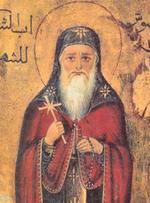The Church Heeds the Lessons of the Ages
A certain depression has taken hold of Catholics today, caused by the clerical scandals of the past few years plus the overwhelming incompetency of so many bishops to deal with the problems or even to recognize a problem.
These things verify what Pope Paul VI said, that the smoke of Satan was in the church, and the church was undergoing a Good Friday. We worry about the church we love; we hear the media criticize her. We are confused.
No disciple is greater than his master, thus the church must endure the passion of her Christ and bear the jewels of His sacred wounds in order to be triumphant.
In the fourth year of the third millennium, as we stand in the night praying, hoping, pleading for the break of dawn, we must travel backwards in time across the present and yesterday to the start of the second millennium. Those years were just as depressing as our own, or even more so. The years prior to the year 1000 were, according to one writer, "one of the most lamentable periods, perhaps the most tragic, recorded in the annals of ecclesiastical history."
The problems facing the church at that time were:
- Ecclesiastical discipline was in disarray. Priests and bishops did as they wished without fear of accountability.
- There was a general collapse in the sexual morality of priests and bishops. They flouted celibacy by marrying and having families.
- Simony. Religious offices were bought and sold.
These were the Dark Ages, the time of the barbarian invasions, a time when the courage and tranquil wisdom of the church were needed but she, herself, was disabled.
Preaching had ceased; the sacraments were neglected; theology was at its lowest point in centuries; education was almost nonexistent; the liturgy was poorly celebrated; and art and architecture were in decline.
The priests of the 10th century were, for the most part decadent and absent, but the bishops were no better. Indeed, the bishops were so bad that Pope Formosus actively gave consideration to excommunicating the entire English hierarchy.
At one meeting of local bishops, a monk came in — uninvited — and looking at the bishops assembled there, said, "Satan sends you his greetings."
There were a few reform-minded bishops. One of them, Cardinal Humbert, said to his brother bishops words that today ring true: "We, the hounds of God, so far from barking fiercely and biting the robbers, go about yapping and wagging our tails, blind flatterers that we are, and, thus, we encourage every act of robbery."
During these days of darkness and scandal, there were forces of reform at work, forces which grew more formidable and more numerous as the second millennium ... approached. The lay faithful, weary from the moral laxity of the priests and their neglect of their duties, became enraged when the bishops refused to do anything about it. Across Europe, riots broke out in cathedrals and the palaces of bishops were attacked and vandalized, sacked and pillaged.
Then came the great reformers: Pope Sylvester II, the first Frenchman to be pope, Nicholas II, Leo the IX and St. Gregory VII. Leo IX reigned for only five years, but during those five years he traveled across Europe convoking synods in various countries, ordering priests to be celibate, writing new laws and deposing bishops. Imagine the cry going out from diocese to diocese, "Leo is coming, Leo is coming." No more business as usual.
A French historian wrote, "The night of the 10th century is an indubitable fact, but we should not forget the dawn that followed, a dawn unconscious, awaited and made possible by the men of this unhappy time."
What would the year 1000 bring? It would begin to usher in the greatest period of time the church has ever known — the high Middle Ages, the time of Christendom, the birth of the university, the erection of the great cathedrals, the great evangelization of Europe, the age of St. Thomas Aquinas, St. Francis of Assisi, Bonaventure and Innocent III. It is rightly called by historians the "Age of Faith."
But this Age of Faith, the great civilization of the Middle Ages, was achieved by the countless persons, lay and cleric, who prayed and worked tirelessly and suffered much, to reform, to purify the church and restore her to her ancient practices.
The church, beaten and scourged by scandal and betrayed by her own leaders, rose like the phoenix from her own ashes, more beautiful, more splendid, more strong, more fruitful than ever before. The church always buries her undertakers.
Looking back on this sorry, sordid time, historian Daniel Rops comments, "During two centuries of increasing night, there then appeared innumerable indications, however small, of a splendid dawn to come. New hordes of barbarians might overcome Christian lands, the children of light might compromise with the sons of darkness, even the very successors of St. Peter might prove themselves unequal to the crisis — but the soul of the church continues to declare herself so youthfully and so vigorously that she ultimately triumphs."
The Catholic Church continues to triumph, because the church is more than her members, she is more than her leaders; she is the very body of Christ.
This item 6248 digitally provided courtesy of CatholicCulture.org






